Presented by Spotlight Cloud

The State of Database Performance Monitoring
Cloud-Based Monitoring is Far from Ubiquitous
Complexity is Part of the Job
Cloud or Open-Source, the Challenges are the Same
We All Want Visibility and Optimization
The Future of Database Monitoring Is in the Cloud
Database performance monitoring has been around in one form or another since the early days of computing. In the beginning, database monitoring consisted of very little functionality and required a high level of expertise to manage, which very few people had at the time.
Fast-forward to the ‘80s and ‘90s, when we saw real-time, interactive monitoring tools standard on almost every desktop and most network systems. This enhanced level of monitoring came with its own set of challenges as infrastructures became more complex and the number of users grew exponentially.
With the explosion of the internet, it became very apparent that traditional database monitoring tools were no longer appropriate for modern, business-oriented computing. Thus began the evolution toward the database monitoring solutions we rely on today.
As database monitoring tools have evolved to handle today’s data-driven business model, the role of database administrator has adapted to keep pace. In the beginning, DBAs were essentially custodians of data. They stood up and maintained their organization’s servers and worked almost exclusively within that system for every workload.
DBAs are now a critical part of business operations and help drive strategy and ROI across the enterprise. It is no longer sufficient for DBAs to simply keep databases up and running. They need a deep understanding of how the data impacts business decisions as DBA responsibilities become less about database administration and more about data modeling, security, and performance. As more enterprises move data and business operations from on-premise to the cloud, many DBAs feel
there is another wave of change on the way, and they wonder where they’ll fit in when platform-as-a-service (PaaS) and software-as-a-service become the norm for database administration and performance monitoring.
To gauge where we are currently in the shift from on-premise database platforms to cloud-based infrastructures, we went straight to the source. Spotlight Cloud surveyed DBAs, DevOps practitioners, developers, and IT and cloud architects to learn more about the state of database performance monitoring.
Our goal was to find out the maturity level of cloud-based monitoring today, the challenges organizations face with adopting cloud infrastructures, and how moving databases and monitoring to the cloud is being prioritized within the business.
Over the past few years, we have heard a lot about the benefits of moving infrastructure to the cloud. So much, in fact, that it sometimes feels like if your organization isn’t heading that direction, you’re being left behind.
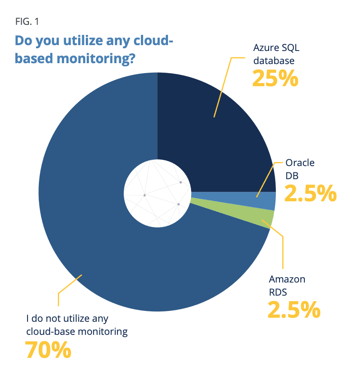 When it comes to database monitoring, however, it appears a mass migration to the cloud isn’t underway. We found that the majority (70 percent) of survey respondents are currently not utilizing cloud-based monitoring solutions. (Fig. 1)
When it comes to database monitoring, however, it appears a mass migration to the cloud isn’t underway. We found that the majority (70 percent) of survey respondents are currently not utilizing cloud-based monitoring solutions. (Fig. 1)
Many respondents cited cost as the top reason for not making the move from on-premise to the cloud for database monitoring. Several others said their organizations haven’t migrated monitoring to the cloud because they are worried about the learning curve associated with implementing a new platform.
Security concerns always make the list of roadblocks to cloud migration, and our survey was no different. Keeping data secure rounded out the top three reasons organizations are hesitant to shift database infrastructure and monitoring from on-premise to the cloud.
Interesting side note: Of the 30 percent of respondents who have made the move from on-premise to cloud-based monitoring, one quarter have adopted Azure SQL Database as their PaaS of choice.
Database administration is in a state of flux because data increasingly drives business decisions and strategies. In many industries, data is practically currency, which makes properly managing and monitoring databases highly complex.
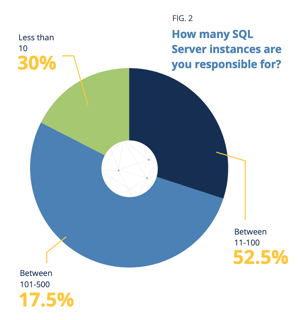 Today’s DBAs are responsible for managing huge numbers of instances across many different platforms, which creates a complex environment in which to navigate security, performance, and availability. The majority of survey respondents (52.5 percent) report that they are responsible for between 11-100 SQL Server instances.
Today’s DBAs are responsible for managing huge numbers of instances across many different platforms, which creates a complex environment in which to navigate security, performance, and availability. The majority of survey respondents (52.5 percent) report that they are responsible for between 11-100 SQL Server instances.
Almost a fifth of respondents manage between 101-500 instances. (Fig 2)
In addition to managing dozens or hundreds of SQL Server instances, many survey respondents are working across multiple platforms, including MySQL, Oracle, and PostgreSQL. Survey results show that only 10 percent of respondents manage just SQL Server databases.
Almost one third (32.5 percent) manage SQL Server databases plus two additional platforms, and more than one quarter of respondents (27.5 percent) manage SQL Server plus three additional platforms. (Fig. 3)
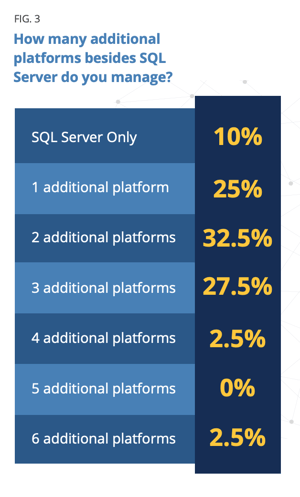
Survey findings indicate that platform type—for example, cloud versus open source—doesn’t have much effect on who makes the decisions, who manages the database platforms, and what the major pain points are. When it comes to deciding what database platform to use, IT management and DBA management are in charge, regardless of whether you are implementing a cloud or an open source solution. (Fig. 4)
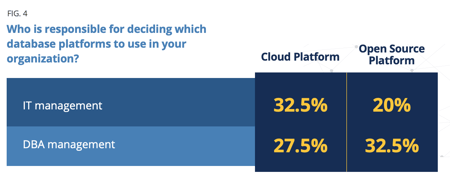
IT management (32.5 percent) and DBA management (27.5 percent) are most often responsible for identifying cloud database platforms for use. Similarly, DBA management (32.5 percent) and IT management (20 percent) are the responsible parties for identifying open source database platforms. However, developers appear to play a larger decision-making role with open source than with cloud databases, with 12.5 percent reporting that devs are most responsible for identifying open source platforms in their organization.
It’s no surprise to learn that DBAs are responsible for managing the cloud database platforms in 70 percent of respondents’ organizations and managing the open source database platforms in 50 percent of organizations. But it is surprising to learn that almost a quarter of respondents (22.5 percent) don’t know who manages their open source database platforms. This data point provides the perfect segue into the challenges organizations face with managing database platforms. (Fig. 5)
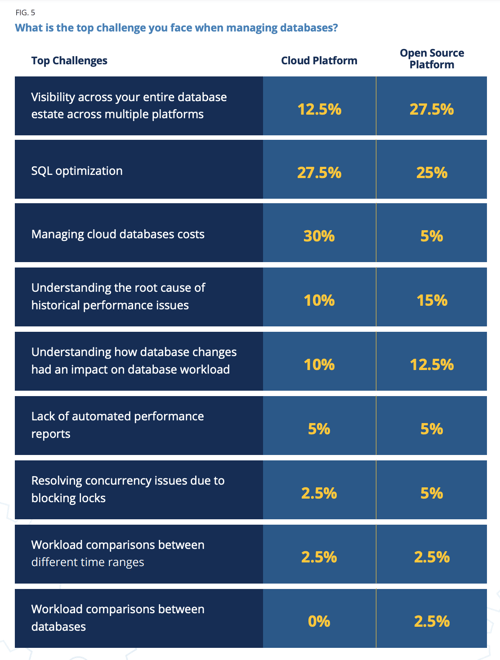
Regardless of platform type, both open source and cloud-based database managers struggle with the lack of visibility across the entire database estate and multiple platforms. However, responses do indicate it’s a bit less of a struggle on cloud database platforms.
SQL optimization is cited as another of the biggest challenges on both open source and cloud database platforms. Optimizing SQL queries improves performance by identifying the most efficient query plan for your SQL statement. Organizations can benefit from implementing SQL optimization tools that reduce the execution time of procedures and improve the performance of SQL instances by reducing the workload of inefficient queries.
Although cloud and open source database platforms have several challenges in common, cloud database managers have more trouble managing costs (30 percent), and open source database managers struggle more to isolate the root cause of historical performance issues (15 percent).
The purpose of database monitoring is to ensure instances are up, available, and running smoothly. According to the survey findings, there are several universal challenges that often prevent us from meeting this standard.
When looking at database monitoring as a whole, the biggest complaint from survey respondents is that most organizations lack centralized monitoring capabilities. This is a common theme throughout the survey.
Our big, complex database systems make it difficult to keep track of how instances are performing because multiple systems equal multiple monitoring solutions. (Not to mention that every additional vendor you add to the mix introduces more security vulnerabilities and expands your attack surface for malicious actors.)
Finding and fixing the root cause of an issue is key to maintaining a healthy database. But survey respondents say their monitoring solution makes it difficult to identify the root cause of performance problems. This can lead to long-term frustration for users experiencing increased downtime, slow queries, and blocked processes.
Identifying the root cause of an issue allows you to proactively manage issues and alleviate symptoms before they impact the performance of the SQL Server instance and end users.
Optimizing database performance is easier when you track performance metrics over time. Unfortunately, many survey respondents cited lack of historical data as one of their biggest challenges in database monitoring.
Although the survey results show that there hasn’t yet been widespread adoption of cloud database monitoring tools, the responses also provide signs that this might soon change.
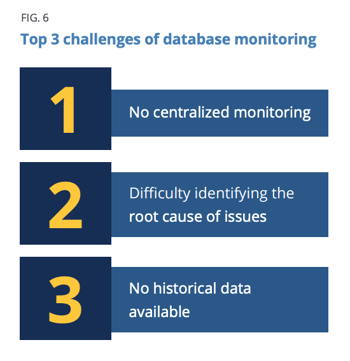 When asked to name the main priorities for IT/DBAs when it comes to database monitoring, respondents most frequently cited monitoring down instances, centralized monitoring, and performance tuning as their top goals.
When asked to name the main priorities for IT/DBAs when it comes to database monitoring, respondents most frequently cited monitoring down instances, centralized monitoring, and performance tuning as their top goals.
Many cloud-based monitoring solutions provide these capabilities and many other performance-improving features that traditional database monitoring tools either can’t do at all or can’t do well. As DBAs continue to seek out ways to optimize performance, streamline database management, and reduce complexity, the logical place to look is in the cloud.
Some DBAs express concern that there will be no place for them once workloads move into the cloud because these managed services handle many traditional DBA tasks, like backups and updates. But the reality is that, although the role of the DBA may look different in the cloud, they are arguably even more valuable to the organization in that environment.
With an increased focus on helping the company meet its business objectives—many of which revolve around data—who better to have on the team than the people who know the data best? Data is king in today’s business environment, and those who don’t learn to manage their data well will fall behind. Additionally, database performance is a critical differentiator in our fast-paced, information driven technology landscape, and traditional monitoring solutions will be hardpressed to keep up.
So what’s next for database monitoring? As the survey results show, there isn’t currently a high level of cloud monitoring maturity. But, given the common challenges and priorities for going forward, cloud capabilities are best suited to meet enterprise needs and expectations.
Businesses will be committed to streamlining processes and seeking out the maximum ROI. Cloud-based monitoring solutions will help enterprises meet these goals with low-cost, low-maintenance SQL database monitoring tools that reduce complexity, increase visibility, help isolate the root cause of performance issues, and offer ideas for how to fix those issues.
 The Complete Guide to Creating PersonasDownload this guide and our bonus persona template.
The Complete Guide to Creating PersonasDownload this guide and our bonus persona template.
